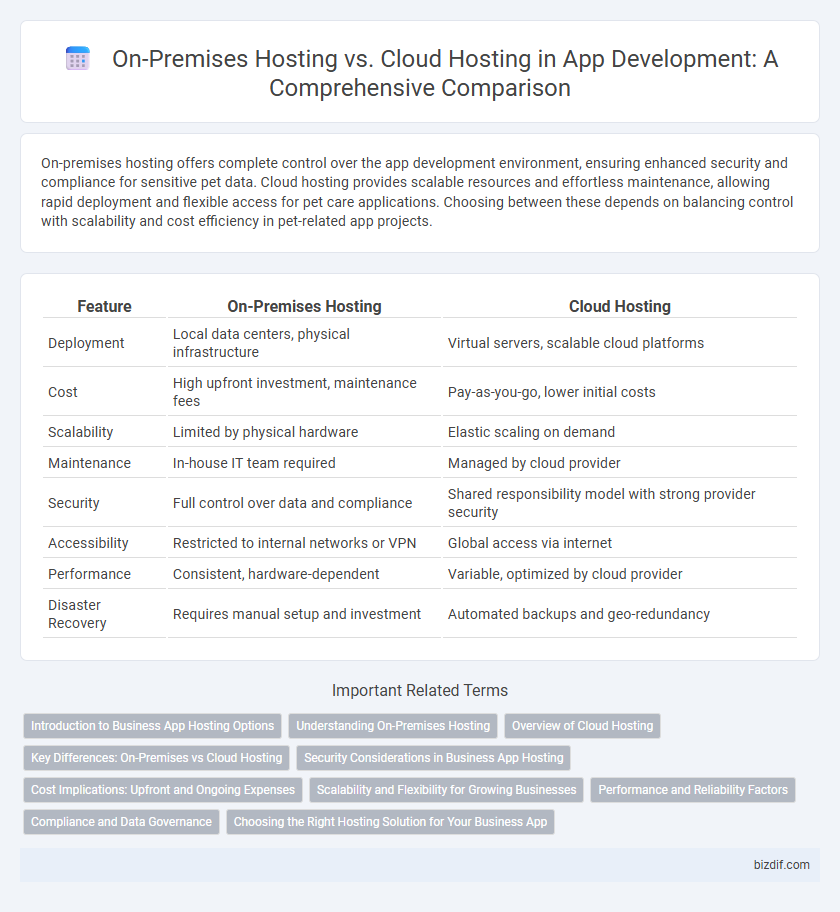On-premises hosting offers complete control over the app development environment, ensuring enhanced security and compliance for sensitive pet data. Cloud hosting provides scalable resources and effortless maintenance, allowing rapid deployment and flexible access for pet care applications. Choosing between these depends on balancing control with scalability and cost efficiency in pet-related app projects.
Table of Comparison
| Feature | On-Premises Hosting | Cloud Hosting |
|---|---|---|
| Deployment | Local data centers, physical infrastructure | Virtual servers, scalable cloud platforms |
| Cost | High upfront investment, maintenance fees | Pay-as-you-go, lower initial costs |
| Scalability | Limited by physical hardware | Elastic scaling on demand |
| Maintenance | In-house IT team required | Managed by cloud provider |
| Security | Full control over data and compliance | Shared responsibility model with strong provider security |
| Accessibility | Restricted to internal networks or VPN | Global access via internet |
| Performance | Consistent, hardware-dependent | Variable, optimized by cloud provider |
| Disaster Recovery | Requires manual setup and investment | Automated backups and geo-redundancy |
Introduction to Business App Hosting Options
On-premises hosting involves deploying business applications on local servers within an organization's infrastructure, offering greater control over data security and customization. Cloud hosting delivers applications through internet-based services, providing scalability, reduced maintenance costs, and rapid deployment. Choosing between on-premises and cloud hosting depends on factors like regulatory compliance, budget considerations, and expected application traffic.
Understanding On-Premises Hosting
On-premises hosting involves deploying application infrastructure within a company's own data centers, providing full control over hardware, security, and compliance measures. This hosting model is preferred for organizations needing stringent data governance, low latency, and custom configurations that cloud services may not support. On-premises environments require significant upfront investments in physical servers, maintenance, and skilled IT personnel to manage updates and scalability.
Overview of Cloud Hosting
Cloud hosting offers scalable, flexible infrastructure that supports dynamic app development and deployment, reducing upfront hardware costs. It provides high availability and automatic resource allocation through distributed data centers, enhancing performance and reliability. Cloud platforms often include integrated security features and compliance tools, facilitating easier management of app environments.
Key Differences: On-Premises vs Cloud Hosting
On-premises hosting involves deploying and managing applications on local servers within an organization's infrastructure, offering enhanced control and security but requiring significant upfront investment and maintenance. Cloud hosting leverages remote servers managed by third-party providers, enabling scalable resources, reduced operational costs, and flexible accessibility through internet connectivity. Key differences include ownership and management responsibilities, scalability options, cost models, and disaster recovery capabilities, where on-premises favors fixed assets and cloud prioritizes dynamic resource allocation.
Security Considerations in Business App Hosting
On-premises hosting offers greater control over security configurations, allowing businesses to implement customized firewalls, access controls, and data encryption tailored to specific compliance requirements. Cloud hosting provides robust, continuously updated security measures managed by providers, including advanced threat detection, automated patching, and distributed denial-of-service (DDoS) protection. Evaluating security trade-offs between physical infrastructure control and cloud provider resilience is critical for safeguarding sensitive business applications and meeting regulatory standards.
Cost Implications: Upfront and Ongoing Expenses
On-premises hosting involves significant upfront costs including hardware purchase, setup, and maintenance expenses, with ongoing costs for power, cooling, and IT staff. Cloud hosting shifts these expenditures to a subscription-based model, reducing capital expenditure but creating continuous operational expenses based on resource usage and scalability needs. Understanding these cost structures helps app developers balance budget constraints with flexibility and performance requirements.
Scalability and Flexibility for Growing Businesses
On-premises hosting offers limited scalability as it requires physical hardware upgrades and long deployment times, making it challenging for growing businesses to quickly adapt to increased demand. Cloud hosting provides dynamic scalability with on-demand resource allocation, allowing businesses to flexibly scale applications and infrastructure without upfront hardware investments. This flexibility supports rapid growth and changing workload requirements more efficiently than traditional on-premises environments.
Performance and Reliability Factors
On-premises hosting offers direct control over hardware resources, resulting in consistent performance tailored to specific app requirements, although it demands significant maintenance and upgrade efforts. Cloud hosting leverages distributed infrastructure and scalable resources, ensuring high availability and resilience through redundancy and automated failover mechanisms. Performance optimization in cloud environments benefits from global data centers and elastic resource allocation, while on-premises setups provide low-latency access within localized networks.
Compliance and Data Governance
On-premises hosting offers enhanced control over compliance and data governance by enabling organizations to implement tailored security policies and maintain direct oversight of sensitive data. Cloud hosting provides scalable compliance solutions with certifications such as ISO 27001, GDPR, and HIPAA, but requires reliance on the provider's security frameworks and shared responsibility model. Organizations must evaluate their regulatory requirements and data sovereignty needs to determine the optimal hosting environment for app development.
Choosing the Right Hosting Solution for Your Business App
On-premises hosting offers businesses full control over their app infrastructure with enhanced security and compliance, making it ideal for industries with strict data regulations. Cloud hosting provides scalable resources, reduced upfront costs, and faster deployment, supporting dynamic workloads and remote access for modern app demands. Selecting the right hosting solution depends on your app's performance requirements, budget constraints, and long-term scalability needs.
On-premises hosting vs Cloud hosting Infographic

 bizdif.com
bizdif.com